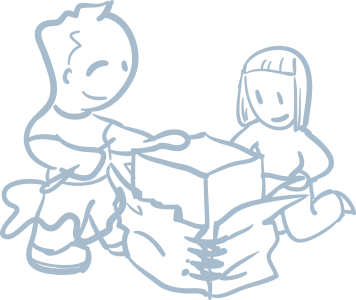Real-life experience: we draw on the child’s personal experience
We draw on the personal experience a child has been forming from the moment they were born: at home, with their parents, while exploring the world in front of their house, or with their playmates in the sandbox. We build on natural, concrete experience that a child can use to form general conclusions. For example, children “sew a dress” for a cube, automatically learning how many faces, vertices and edges the cube has, how to calculate its surface area...
No doubt you can imagine the progress of a child who, at first, is only able to show three fingers to indicate three objects, but is later able to write the digit 3, and later still can substitute this digit with the letter “x”. When we are guided by our own intimately personal experience, we are willing to enter a world of complete abstraction.

Mathematics as experience
Mathematics teaching aimed at schema-building is based, above all, on children’s personal experience. When they solve problems, children collect a range of mathematical experiences. When, for instance, a child tries to count three M&M’s, they count one, two, three, pointing at each M&M. He or she will count three apples, three people sitting at a table, three steps, or three claps in a similar manner. The child will then confer with a friend to find out their way of counting, before suddenly coming to the generalization: “Oh, three is always this many,” and showing three fingers.
Fingers become a generic model. They are a substitute model for all previous experiences. The child now knows that three cars is that many (three fingers), even when they cannot see the cars. As a result of these experiences, the child begins to feel ready to write three as a digit; he or she accepts the abstract symbol “3” and starts using it. However, the concept of “three” in the child’s mind is founded on clear numeric images. The child understands the abstract concept. The new piece of knowledge finds its place in the child’s existing structure of knowledge and he or she continues to use it.
Mathematics in intimately known environments
All the mathematical concepts incorporated into the various environments in the textbooks are designed to follow the principles described above. For example, in the “Stepping” environment pupils accumulate experiences with natural numbers, with integers, with the minus sign followed by parentheses, with equations, and with absolute value.
So when 10 year old children are presented with the problem: 2 − (__ − 1) = −1, a pupil may not know how to solve it using numbers. But they have by now gained an array of experiences with counting steps, and these will be used as a tool (the generic model) for the solution. The pupil translates the problem into arrow notation,
|→→|turn around| _____ |←|turn around| = | ←|,
then counts out the steps and finds the solution, as follows: two pupils are counting steps. The first pupil takes two steps forward, turns around, stays on the spot, then takes a step backwards, and turns around. The other pupil takes one step backwards and stops. What will the first pupil need to do to stand next to the other?
Experience can only be gained, not transmitted
The trouble with acquiring experience is that experience cannot be transmitted. It can only be gained. There is only one way for a child to acquire experience in mathematics – by solving a problem. Any effort to make a pupil’s path to understanding shorter and to try to “pass on the experience” only addresses a momentary situation. No matter how noble our intentions, in reality we are doing the pupil a disservice. The knowledge we pass on to them is formal, and is only stored in their mind temporarily. In effect, it is not knowledge in the true sense of the word.
We can judge the accuracy of the above statements by referring to our own life experience. It should suffice to recall the frequency with which a mother scolds her child: “How many times have I told you..?” The child will still cut their finger, fall off a chair and not brush their teeth. They do not care how many times someone has told them. To learn to be careful, the child needs to gain experience; that is, they actually need to cut their finger or fall off a chair. You may recall the line “Do not lick the hand-rail,” from the movie Elementary School (Obecná škola). Just after watching this movie, we caught a boy who had got his tongue stuck to a fence pole because he did not believe that what he had seen in the movie was true.
Experience through failure
On the other hand, the advantage of learning through acquiring experience is that a pupil gains experience even when they do not manage to solve a problem. They benefit from the very fact that they have tried to solve the problem, and were mentally engaged in it.
No lesson is lost as long as the pupil is engaged in work. The pupil still acquires experience, even if they do not achieve a particular goal. They confirm that this particular way does not lead to a solution. They find out what other things they will need in order to solve the problem successfully. They realize, for instance, that they would benefit from knowing how to multiply small numbers. These situations are important for pupils; they will be able to capitalize on them in the future.
